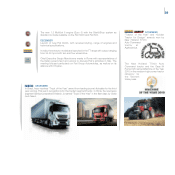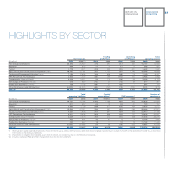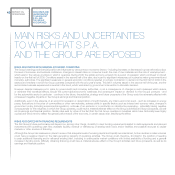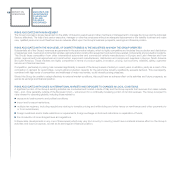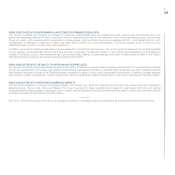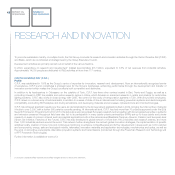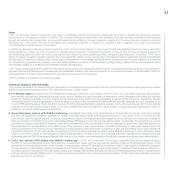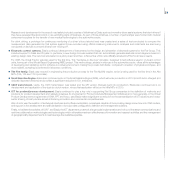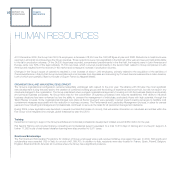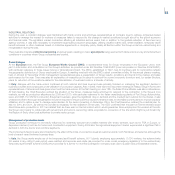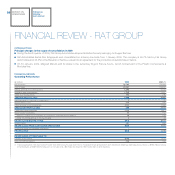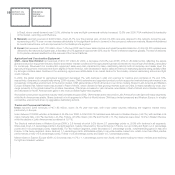Chrysler 2009 Annual Report Download - page 49
Download and view the complete annual report
Please find page 49 of the 2009 Chrysler annual report below. You can navigate through the pages in the report by either clicking on the pages listed below, or by using the keyword search tool below to find specific information within the annual report.
REPORT ON
OPERATIONS
RESEARCH
AND INNOVATION
48
New S30 F1C 3.0-litre Bifuel TC engine (CNG/gasoline). The S30 (F1C) 3.0-litre, 4-cylinder, 16-valve Bifuel Turbo engine (CNG/gasoline), which
has now entered production, is based on a combination of spark ignition stoichiometric CNG engine technology with supercharging and the bifuel
concept, which enables the vehicles to operate on gasoline as backup in the event that CNG refuelling is not readily accessible. The existing CNG engine
was optimised to achieve performance comparable to some diesel versions (100 kW and maximum torque of 350 Nm at 1500 rpm) and to reduce fuel
consumption and emissions, particularly of NOx and CO2.
The S30 Bifuel Turbo engine has not only bridged the performance and reliability gap that separated heavy duty CNG engines from their heavy duty
diesel counterparts, it has also demonstrated a clear advantage in terms of emissions without significant increases in costs. In road tests, running costs
were shown to be 30%-40% lower than for an equivalent diesel. Work carried out by C.R.F. (Orbassano and Foggia) during 2009 enabled production on
versions of the S30 Bifuel Turbo engine for application on the Ducato and the Daily to be launched and also led to making the engine compatible for use
with biomethane, as well as CNG/hydrogen blends (up to 30% hydrogen by volume) for the subsequent launch of pilot fleets already planned for Italy.
First Italian fleet of CNG/hydrogen-powered vehicles. The use of CNG/hydrogen blends represents a key step toward the use of pure hydrogen.
Using technologies developed for large scale application to CNG, emissions of CO2, hydrocarbons, carbon monoxide and nitrogen oxides can be
reduced significantly. During 2009, development was completed on an experimental fleet for the Region of Lombardy, consisting of 20 Fiat Pandas
(Natural Power) which run on a blend of 30% hydrogen and 70% CNG (by volume). During the trial, a data acquisition system on board each vehicle will
collect the necessary data to monitor the correct functioning of the vehicles and record the level of fuel consumption and CO2 emissions.
Research into CNG/hydrogen blends also includes development of a Hydromethane EcoDaily as part of an experimental programme with Autostrada
del Brennero S.p.A. This project represents a further step towards sustainable mobility, as the hydrogen used in the blend is produced from the energy
surplus of a hydroelectric power plant.
Advanced Technology for Mobility and Safety
The principle objective of this activity is to guarantee Fiat Group the technical know-how in secondary systems, electronics, telematics and preventive
safety necessary to improve mobility by making vehicles safer, more versatile and more eco-compatible. Major achievements in 2009 included:
Active/passive safety systems integrated with infomobility technology. One of the existing challenges for mobility is the temporal and spatial
extension of driving safety through the use of wireless Vehicle-to-Vehicle and Vehicle-to-Infrastructure communication technologies. The European
Commission considers road safety and effective traffic management to be high-priority issues and, as such, has given significant support to various
research projects focused on the development technologies and applications based on collaborative systems.
Three large projects (SAFESPOT, CVIS and COOPERS) and numerous others co-financed by the European Commission are developing technologies
and an integrated, interoperable architecture for the development of information exchange network which will enable sustainable mobility for the future.
C.R.F. coordinates Europe’s largest collaborative vehicle project, SAFESPOT, which is a partnership of 52 companies from all over Europe. The objective
is to develop technologies to create an interoperable communications network connecting vehicles and road infrastructure. In partnership with the Car-
2-Car Communication Consortium, the SAFESPOT project has identified technologies and communication protocols that meet specific requirements for
application to solutions that will improve road safety.
ABS Supersteer™ system. The result of a partnership between New Holland Innovation in Modena and C.R.F., this system is specifically designed for
agricultural applications and combines various innovations such as: a pneumo-hydraulic braking system; ABS control specifically developed for the most
critical braking conditions for a tractor (e.g., conditions of asymmetric traction); standard functions for use in the field (e.g., steering lock and automatic
braking, hill holder, etc). At Agritechnica 2009 in Hannover, Europe’s largest agricultural equipment show, the ABS Supersteer™ system was awarded
the Silver Medal for Innovation.
Low environmental impact auxiliary systems. During the year, C.R.F. continued testing innovative climate control systems that minimize environmen-
tal impact and energy consumption, while at the same time increasing efficiency.
On the consumption side, Smart Cooling is being developed as an integrated management system for all thermal flows, resulting in a clear improvement in
the total energy usage and a 5% reduction in consumption measured by the NEDC (New European Driving Cycle) standard. In the Smart Cooling system,
the traditional condenser and intercooler are replaced with water exchangers located within the engine cavity and served by a secondary low-temperature
water and glycol circuit (at approximately 50°C). Given that there is only one fluid in the front section of the vehicle, the system can actively manage the
division of the heat exchange surface between the engine cooling circuit (at 90°C) and the low-temperature circuit.



